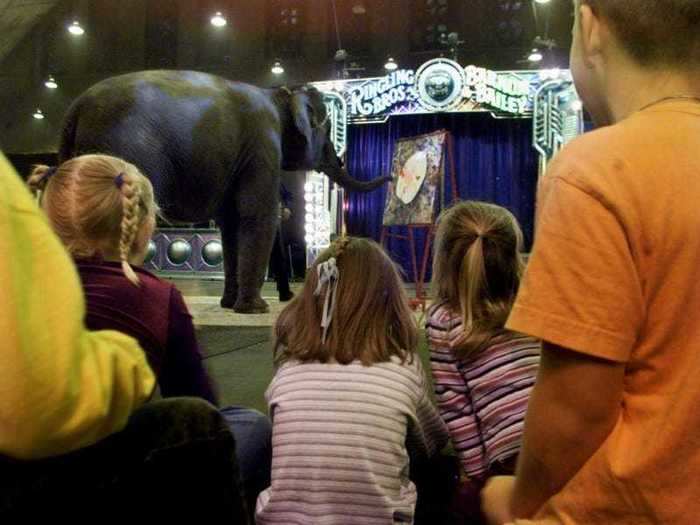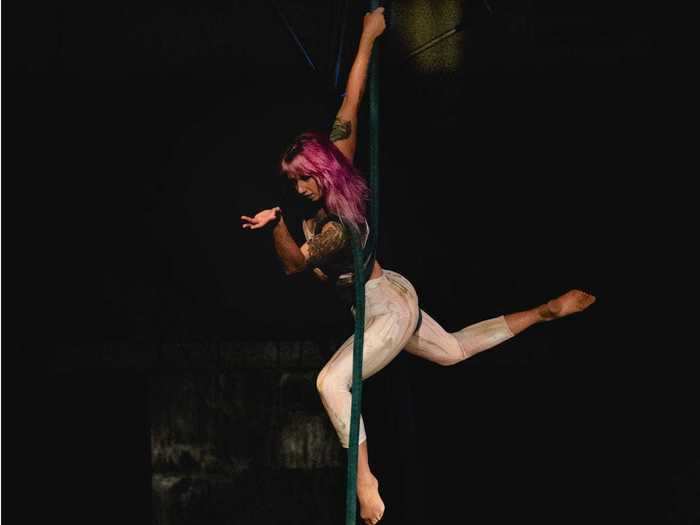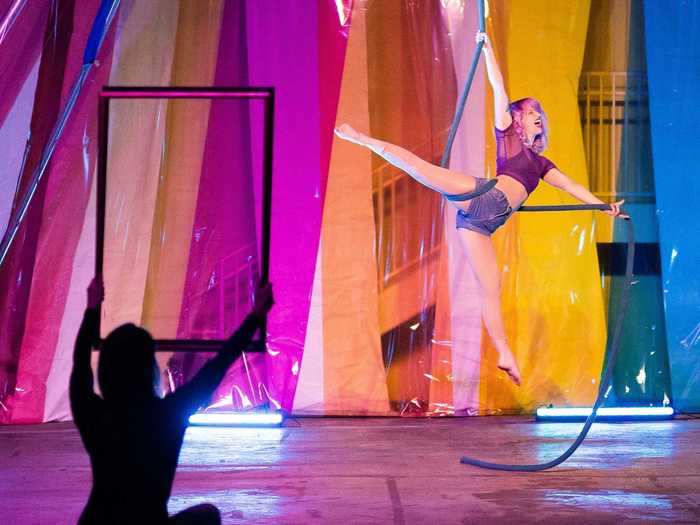Bailey Freeman.Curious Humanography
- Bailey Freeman is a circus artist with Suspended Gravity and resident instructor at Fall Aerial Arts in Nashville, Tennessee; she specializes in corde lisse, silks and aerial sling, along with chair acrobatics and veil poi.
- Circuses have had to adapt to audience-free environments, including using online streaming alternatives to perform and teach.
- But for many, it has meant temporarily shuttering, given depleted demand and financial strain.
- Visit Business Insider's homepage for more stories.
When one commits to the circus arts, it becomes more than a job — it's a way of life. As an aerial acrobat, I spend countless hours in the studio developing strength and skill, producing multiple original productions a year with my circus collective, and teaching others how to fly using nothing but their own bodies. There's no halfway when it comes to the art of being superhuman — you're all in.
This commitment makes the circus arts what they are: unbelievable. People flock to the circus to participate in a sensory entertainment experience that defies logic and stokes the imagination. It's an industry that thrives on spectacle and audience reaction — but what happens when the audience is gone, quarantined away due to a health crisis?
The circus arts, like many other performing arts industries, have faced economic and functional difficulties resulting from the global COVID-19 pandemic. And while it seems niche, modern circus is more prevalent in our culture than one might think. Cirque du Soleil is perhaps the most well known example, but the circus arts manifest in many different places in everyday life: bars and clubs, arts and music festivals, corporate events, and circus schools and studios across the country.
In the wake of COVID-19, venues have closed to protect the crowds that are their lifeblood and studios have emptied to protect their students. In late March, Cirque du Soleil temporarily laid off 95% of its workforce as it shuttered its shows around the world, and many other global productions have faced similar fates — Cambodia's Phare Circus has suspended activity, as has the Montreal-based The 7 Fingers. The pressure is on: How does this historic art form adapt to this unprecedented challenge?
Read the original article on
Business Insider
The future of circus post-COVID
The industry will adapt.
Thomson Reuters
While the world's newfound confinement has created new hurdles to jump, the circus industry has quickly risen to the challenge. This movement towards the digital sphere marks an interesting moment for the arts in general — not only does it provide an alternate means of income for the artists themselves, but it also invites a conversation regarding the accessibility of art.
Will this new movement of digital classes and performances continue on after the world reopens? The answer to this question remains to be seen.
The circus arts have been successful for so long because they teach people to believe in the impossible. Circus artists push the limits of our own human-ness into something wondrous, fantastical, and thrilling, providing the audience with a mental escape from the confines of daily life (and sometimes even physics). In a time when our big world feels so confined, we all need a little bit of that magic.
Teaching circus arts, COVID-style
The author.
PirateSiren Photography
Circus performance requires a monumental amount of training, a task that becomes a challenge when the world's specialized training spaces are unavailable. Tumblers have lost access to their gymnastic floors while trampoline artists have been left trampoline-less. Aerialists can no longer hang from their rig points, and partner and group acts have been separated by social distance.
And that's where the internet has come in, changing the face of circus training in light of COVID-19. Zoom, Facebook, and Instagram Live offer new platforms for reaching people near and far; artists and students can find classes and tutorials in hand balancing, juggling, dance, aerial conditioning, and more.
The acrobatic arts require some particularly creative planning given the space and equipment limitations imposed by the virus quarantine measures. Maintaining baseline fitness during the quarantine period reduces the risk of injury (the consequence of doing too much too fast) once studios, schools, and stages reopen, and coaches and performers are finding inventive ways to keep skill and strength loss to a minimum.
The New England Center for the Circus Arts, one of the leading circus education facilities in the United States, has tweaked its program — it now hosts virtual private lessons as well as group "pay-what-you-can" classes designed to be done at home. Students can participate in specially designed virtual floor-based conditioning programs and classes created to incorporate tools they have in your home, like "Strength and Conditioning with a Foam Roller."
Similarly, the Circus Center in San Francisco, another facility with expansive circus education offerings, has turned to the internet to deliver instruction in strength and flexibility skills. Classes include online "Circus Bootcamp," hand balancing classes and advanced flexibility courses.
Moving the spectacle to the screen
The author.
Bessire Photography
With the closure of public spaces, many production houses and shows are finding new ways to share their art with a much more far-flung audience. Local shows have the potential to become international features, thanks to the wonders of the internet and the universal hunger for relief from pandemic stress.
Before the pandemic, Cirque du Soleil utilized the digital sphere to share behind-the-scenes footage, training videos, and cirque makeup tutorials via YouTube; since the closure of their shows, they've gone a step further, televising highlights from their massive library of productions weekly, featuring acts from both resident and traveling shows. These hour-long features explore the mind-bending feats of classics like Alegria and O, as well as international shows like Luzia and Bazzar.
Similarly, some performing arts festivals are finding new ways to support circus artists as the international festival scene continues to shrink. The Adelaide Fringe Festival, frequently filled with circus acts, recently announced their initiative called FringeView, inviting artists to submit videos of their acts, virtual workshops, and tutorials to create a roster of curated ticketed events. Funds from the "attendees" will be directly given to the artists; Fringeview will be running for the entire month of May.
Many small troupes and freelancers are also using the internet to cover the economic loss from cancelled gigs and projects, organizing quarantine-friendly shows and cabarets broadcast easily across social networks. While some are ticketed, many are free, only asking for donations in support of their art and livelihoods. Quarantine Cabaret, for example, has embraced the challenges of remote "live entertainment" bringing together circus, drag and burlesque artists for weekly performances full of humor and talent. Like what you see? Viewers can send tips via Venmo.



